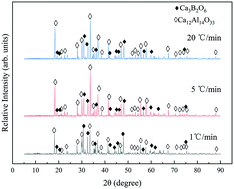Effects of the cooling rate on the crystallization behaviors of the CaO–Al2O3–B2O3–CaF2-based mold flux
Abstract
In the casting of steel, the crystallization behavior of the mold flux has an important effect on the cast quality. A new type of CaO–Al2O3–B2O3–CaF2-based mold flux for high aluminum steel casting has been designed. The effects of the cooling rate on the crystallization behavior were investigated using confocal scanning laser microscopy (CSLM) and a high temperature tube furnace. The Ca3B2O6 and Ca12Al14O33 crystals precipitated at cooling rates of 1, 5 and 20 °C min−1. The primary crystal morphology of Ca12Al14O33 gradually changed from an irregular massive block shape to a moderate faceted shape, as the cooling rate increased from 1 to 20 °C min−1. The morphology of the Ca3B2O6 crystals also transformed from a large dendritic shape into a small faceted shape, and their size gradually decreased with increasing cooling rate. The glassy phase also increased with increasing cooling rate. Ca12Al14O33 showed four different morphologies at cooling rates ranging from 1 to 800 °C min−1: faceted shape, block-shape with fine stripes, large sheet with cloudy dendrites, and dendrites. The crystallization temperature decreased from 1177.3 to 894.1 °C as the cooling rate increased from 30 to 500 °C min−1. The crystallization mechanism of Ca12Al14O33 was deduced to be surface crystallization for the present slag.



 Please wait while we load your content...
Please wait while we load your content...